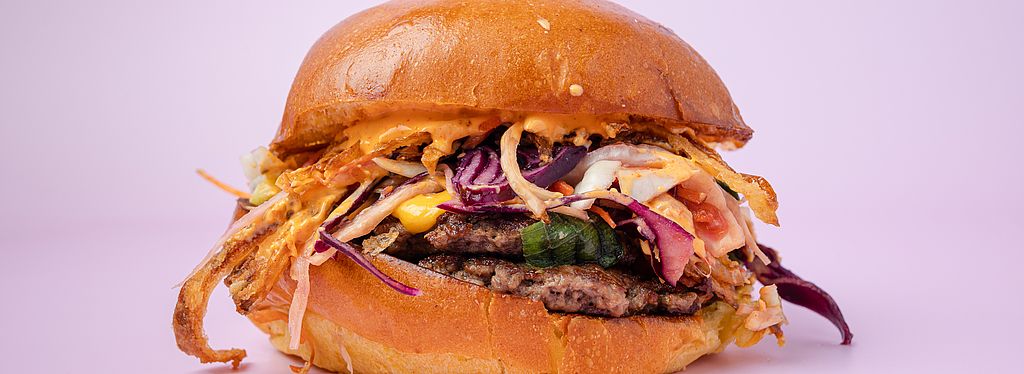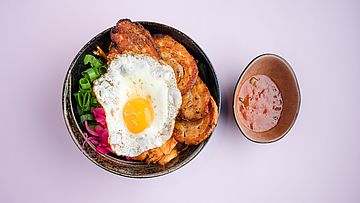Combining national and international trends
Guest-orientation: The curiosity shown by guests regarding international concepts and interesting products shows no sign of abating. With that in mind, new ideas need to be exciting and offer ‘eatertainment’ at its bes
International influences: Nothing in the world compares to the culinary cultures of Asia, the USA and Canada, as well as Mediterranean, Oriental and Nordic cuisines. Asian cuisine in particular, especially that of Korea, Vietnam, Taiwan, Singapore, China and Japan, provides a wealth of inspiration. At the same time, local cuisine is also valued highly, with national and regional dishes more popular than ever. They symbolise comfort, tradition and a sense of security. Furthermore, the short transport routes of regional foods mean a low carbon footprint that makes them particularly sustainable.
Opposites attract: diversity matters.
- Multicolour vs Mono-colour
- Extra sweet vs Less sugar
- Swicy (sweet and slightly spicy) vs Mild and comforting
- Smoky vs Pure
- Special vs Mainstream
- Funky vs Simple
- International vs Regional
- Healthy vs Indulgent
The restaurant and catering industries can benefit from the challenge of combining opposites and appealing to a wide audience.
New, fun and spectacular developments
Asia
Asian burgers: New interpretations of burgers with an Asian touch are extremely popular. These include the gua bao burger from Taiwan, the bao bun, which originated in China, and the Korean kimchi burger.
Bulgogi: Translated literally, this meat dish from Korea means ‘fire meat’, due to the fact it is cooked over an open fire. The wafer-thin slices of barbecued meat are used to prepare bulgogi bowls, sandwiches, burgers and chips. The beef is coated with a sweet marinade made from soy sauce, sugar, spring onions, sesame oil and ginger and served with gochujang mayo and kimchi.
Korean ‘buldak’ chicken: ‘Buldak’ translates as ‘fire chicken’ and is a spicy chicken dish that is very popular in South Korea. Bite-sized pieces of chicken, grilled or deep-fried, are served with a spicy sauce made from gochugaru (Korean chilli flakes), gochujang (Korean chilli paste), matsul/mirin (Korean seasoning sauce) or soy sauce, garlic and other spices.
Soft mochis: Well-known in Japan and Taiwan, these sticky rice delicacies come in sweet and savoury versions, for example with cream cheese, and different forms ranging from mochi ice cream to mochi donuts.
Sweet temptations
Churros: This popular pastry from Spain can be served in a variety of ways: they are a familiar sweet snack available plain or filled in Spain, the UK, the USA and Canada. New variations include the churro dog, a sweet hot dog, and churros with soft ice cream for dipping in a cup.
Smoky balls from Dubai: The ultimate smoky culinary experience: mini dough balls filled with smoke and served with ice cream.
Multicoloured effects with candy floss: These are culinary highlights that originated in the USA and are now also popular in Asian countries including India and Dubai, as well as in Germany. From flying and burning candy floss to shakes, cupcakes, huge sugar flowers, comic-book figures, mini clouds for coffee and sugar-free versions, the diversity of these sweet temptations continues to grow.
Variety of drinks, from health kicks to energy boosts
Cashew fruit juice from India and Africa is an anti-food-waste trend involving sustainable juice made from cashew fruits, which are harvested separately from the cashew kernels. Suppliers of this tasty drink include the West African company Akoua.
Energy drinks with natural ingredients are in demand, and the bottles and cans are becoming increasingly stylish. Today’s market features healthy drinks made with superfruits like baobab from Africa, turmeric and galangal, such as those from Monojuice in Switzerland. These drinks are very popular as options to-go at airports, railway stations, motorway services and in urban areas.
People like things crazy and funky
‘Godzilla meal’ in Taiwan: The classic film ‘Godzilla’ provided the inspiration for a popular new dish in Taiwan consisting of a crocodile foot cooked and served whole.
Music lollies from China: Sucking these lollies brings a treat for the taste buds and for the ears – perfect as sweets for on the go, treats when travelling, vending machines and event catering, as well as a tempting impulse buy at the checkout.
Jellyfish in various forms, such as jellyfish crisps.
Guacamole made from green tomatillo: The tomatillo is a type of berry that resembles an unripe tomato and is often called the Mexican husk tomato. They can be used to make innovative types of guacamole.
Special and unique ideas from around the world
A new cheese trend from the Netherlands: Large, high-quality pieces of fruit, antipasti and vegetables in cheese or as a generous cheese topping.
Chocolate cream made from apricot stones in Austria: Vegan spreads, oils, and milk and cheese alternatives made from various fruit stones (for example from Wunderkern).
Camel milk products in Dubai: From sweets to snacks, a unique culinary experience is provided by products made with camel milk.
Significance for the foodservice and hospitality market
The idea of ‘eatertainment’ at its best and innovations from all over the world arouse the curiosity of guests. Nothing in the world compares to the culinary cultures of Asia, the USA and Canada, as well as Mediterranean, Oriental and Nordic cuisines.
At the same time, local cuisine is also important, with national and regional dishes more popular than ever.
New inspirations from Asia such as gua bao burgers from Taiwan, bulgogi bowls with barbecued meat and buldak ‘fire chicken’ from Korea or mochi donuts and mango bread from Japan and Taiwan offer additional variety for the restaurant and catering industries. International innovations such as smoky balls from Dubai, cashew fruit juice from West Africa and music lollies from China are also interesting developments for the foodservice and hospitality market.
Summary
The influences on the international and domestic food and beverage scene range from the streets of Taiwan to the culinary delights of Dubai. The wide variety of trends presented here makes clear just how significant novel developments and spectacular concepts are for the sector. Eatertainment, Instagrammability and storytelling are now more important than ever before. Guests are keen to make new culinary discoveries and are just as enthusiastic about international concepts as they are about familiar regional dishes.
The global trends are dominated by Asian cuisines, but local and regional delicacies are also very much on the up. The industry can benefit from the way these opposites attract by offering the choice of both healthy and sinful, international and regional or funky and simple.
Innovations such as Asian burgers and the ‘smoky balls’ culinary experience demonstrate that the restaurant and catering industries are ready to break new ground and present unusual concepts. The variety and creativity in the sector – from cashew fruit juice drinks from Africa to sweet treats like music lollies from China – are impressive.
In summary, the future of the restaurant and catering sectors will be shaped by innovation, variety and the pursuit of unique culinary experiences. Those who embrace these trends and cleverly integrate them into what they offer will not only impress their guests, but also create an unforgettable experience that exceeds their expectations.
Karin Tischer und der INTERNORGA FoodZoom
Karin Tischer, the internationally recognised food trend researcher and founder of the food & more research and development institute in Kaarst, compiles the annual INTERNORGA FoodZoom trend analysis for the foodservice and hospitality market on behalf of INTERNORGA. It provides an exciting summary of the food and beverage trends that are shaping the industry. food & more has been developing concepts, innovations and recipes for industry, the foodservice and hospitality market (from large-scale systems to start-ups), B2B providers and retailers for 27 years and is involved in trend research worldwide.
Karin Tischer’s Pink Cube has been the trend forum at INTERNORGA for 11 years and will be presented on the Open Stage for the first time in 2024





